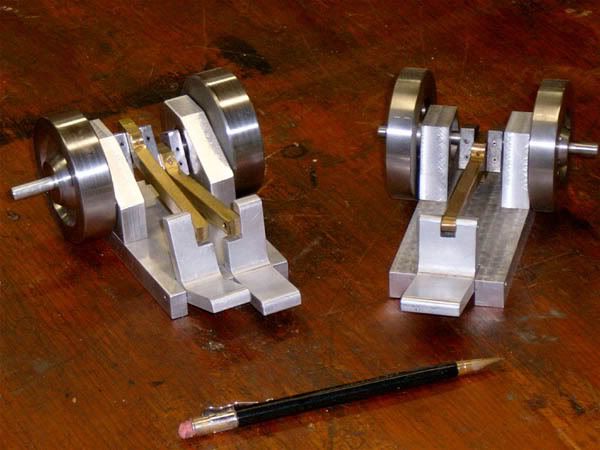B
Bogstandard
Guest
I was having a bit of a discussion with Wareagle about 'bling' and his great little finger engine, this led to me decide that I would give a couple to friends as christmas gifts, as a part 'payment' for all the help they have given me throughout the year, a bottle of scotch will be the other part. This doesn't leave me long to get three done (a little bit of a special one for myself).
So if anyone wants to build one I have done a sketch, not plans, just a 'roughie' with the working dimensions on it, the rest will be a 'wing it' job.
I have picked up a piccy from somewhere, but can't remember where, so if you recognise it, chirp up and you will get recognition for the basic besign.
Now to start.

I drew up some dimensions for a full sided one as in the pic, or as two seperate standards, which is the type I am doing (easier on the ali plate stock). My ali disc has been marked out to give me the rough metal for the six larger standards that are required, and I might be able to get a few of the smaller ones out of the bits I cut off.
There is a selection of bearings, both roller and oilite (decision on what is going to be used comes later) and a couple of bits of brass bar to be the axles. I have already roughed out a couple of 3" flywheels (the ones for mine are still in my head, but will be rather unusual).
So here is my working drawing, I have even kept it in imperial to help our colonial cousins if they decide to try one.

So, bling fairies dragged off my other project for the moment, and full speed ahead on these.
John
So if anyone wants to build one I have done a sketch, not plans, just a 'roughie' with the working dimensions on it, the rest will be a 'wing it' job.
I have picked up a piccy from somewhere, but can't remember where, so if you recognise it, chirp up and you will get recognition for the basic besign.
Now to start.

I drew up some dimensions for a full sided one as in the pic, or as two seperate standards, which is the type I am doing (easier on the ali plate stock). My ali disc has been marked out to give me the rough metal for the six larger standards that are required, and I might be able to get a few of the smaller ones out of the bits I cut off.
There is a selection of bearings, both roller and oilite (decision on what is going to be used comes later) and a couple of bits of brass bar to be the axles. I have already roughed out a couple of 3" flywheels (the ones for mine are still in my head, but will be rather unusual).
So here is my working drawing, I have even kept it in imperial to help our colonial cousins if they decide to try one.

So, bling fairies dragged off my other project for the moment, and full speed ahead on these.
John






















































































